Home pests are sometimes exclusively seen as small brown bugs. From house moths to carpet beetles, many brown bugs are tiny and live inside homes.
Some of these bugs get inside by accident, such as those carried on luggage. Others make their way in purpose either looking for food or shelter.
Many small brown bugs in homes have no real impact as nuisance pests. Others carry and transmit diseases.
Correct species identification is the first step toward eliminating these bugs from the house or the premises.
Here are the most common types of small brown bugs that live in homes or next to homes.
Table of Contents
1. Brown House Moths
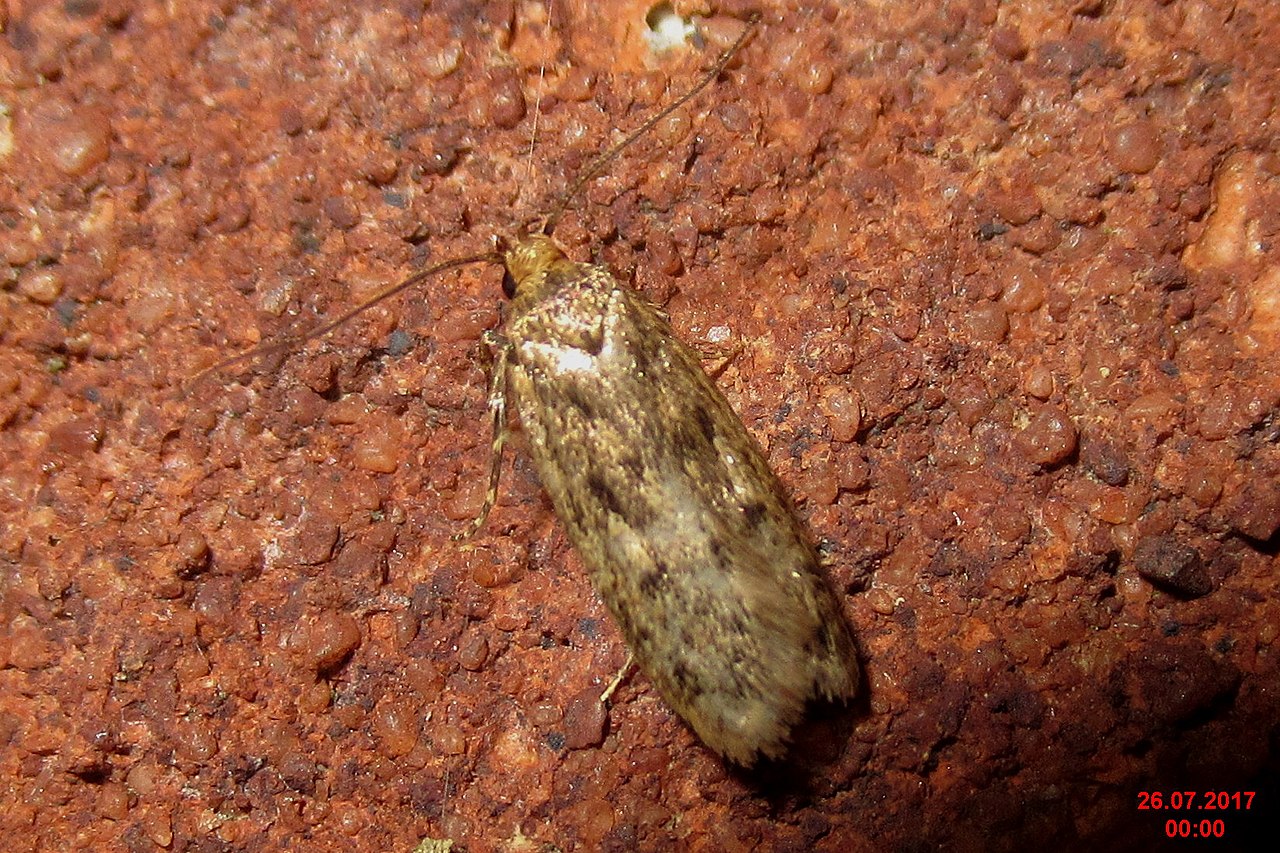
Brown house moths are very common. Present in almost all homes at some point, Brown house moths are identified by their mostly brown color with white, yellow, tan, or gray coloring.
Moths of this genus are omnivorous in the larval stage. They eat almost anything they can find in the house, including leather.
As adults, Brown house moths eat natural fibers such as cotton, wool, and sink.
These fibers are mostly found in clothes. The fibers of natural-fabric clothes are susceptible to partial or total damage when it comes to a moth invasion.
Moths start reproducing in high numbers and eat these natural fibers for up to 6 months.
Some moths live longer, almost throughout the year. These moths are known for damaging natural fibers and clothes throughout the year.
Brown house moths can be eliminated by washing clothes or by throwing away contaminated clothes.
The larvae of Brown house moths can cause even more significant damage, including to food such as flour so you need to check the pantry as well.
2. Indian Meal Moths

Indian Meal moths are also common in homes. They grow to a maximum size between 8 and 10mm and have brown wings and brown heads.
These types of moths have a varied diet, mostly including plant-based foods. They eat dry dog food, pasta, flour, rice, and other similar foods in the pantry.
Indian meal moths can also turn cannibalistic in the absence of these foods for a long time. They eat their larvae.
Meal moths of this genus are very difficult to eliminate. They tend to infest the entire house as they eat almost anything they can find of a plant nature.
Meal moth traps are among the proven methods of getting rid of India Meal moths.
3. Drugstore Beetles

Drugstore beetles are common in homes and commercial units. Their name implies they only live in drugstores where they feed on various medications, but they also live in homes.
These tiny brown bugs are primarily found in commercial facilities. Food manufacturing warehouses are where they live.
They can get into homes with foods from the supermarket or other infested items.
One of the main problems with Drugstore beetles is they can eat through paper and plastic containers which means they get to all stored foods when they make it to the pantry.
Storing food in glass containers is one of the few preventive measures you can take against these bugs.
4. Spider Beetles

Spider beetles are seen as a combination of spiders and beetles in look. These small bugs with a wide abdomen are identified by their dark brown color.
Spider beetles infest homes for food. Unlike spiders who only eat insects, Spider beetles eat almost anything they can find.
This includes flour, beans, rice, wool, and cereals.
All of these foods are found in the pantry and they attract adult and larval-stage Spider beetles.
These bugs can also bite. However, the bite of Spider beetles isn’t too painful since the bugs lack venom.
5. Carpet Beetles
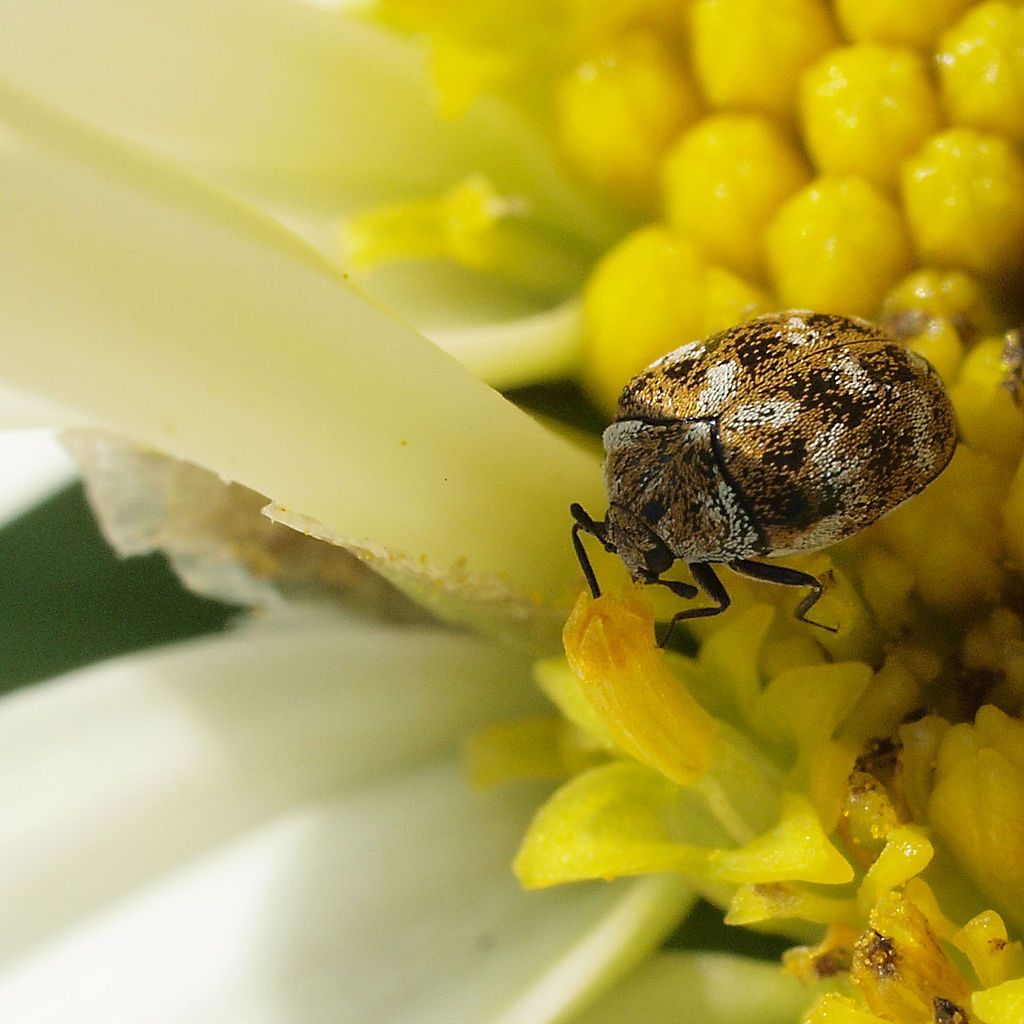
Carpet beetles are found in homes with woolens such as wool carpets and wool clothes.
These bugs get inside homes favored by items that are old or infrequently used and stored in dark damp places.
Carpet beetles don’t love excessive light or being disturbed. This is why they primarily live in closets on old wool clothes that barely get worn or behind hidden carpet seams.
There are a few options for eliminating carpet beetles. You may discard the infested items or consider dry cleaning them after washing them properly.
6. Bed Bugs

Bed bugs are some of the most common small home invaders.
Bed bugs are mostly red when fed. However, they appear brown or transparent brown when not fed.
As a result, you know the tiny brown bugs you see on the bed can bite and they need to be eliminated.
Bed bugs bit and drink your blood at night when you sleep. You can identify a bed bug that has been eaten by its red color from ingesting blood.
Replacing old beds and not sleeping in hotels with bed bugs are the recommended preventive measures.
Bed bugs can damage mattresses and bedsheets which might need to be discarded in the case of an infestation.
7. Bat Bugs

Bat bugs are sometimes confused with bed bugs. Also, tiny, brown, and oval, bat bugs are a parasite of bats.
They can accidentally get into homes when bats move or when bats are eliminated from attics they inhabit.
Bat bugs can bite and they bite humans they come in contact with for blood. However, they need bats to survive which means they never reproduce once separated from their bat host.
These bugs can be eliminated by sealing all entry points for bats, especially gaps in the attic.
Bugs of this genus do not carry diseases, despite coming from bats. Still, they can cause reactions such as skin allergies and irritation given they can inject saliva when biting.
8. Fleas
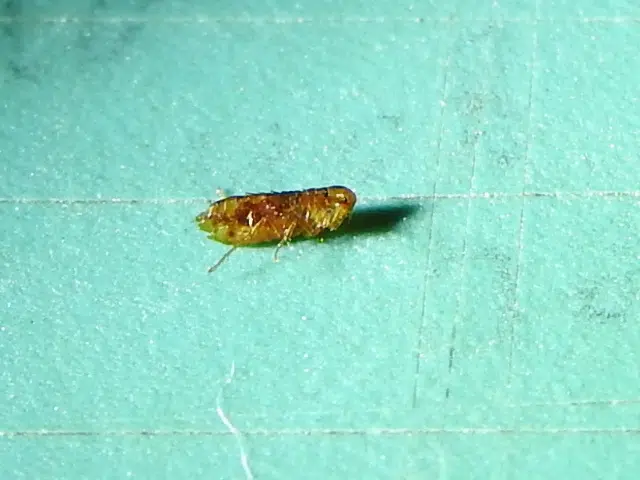
Fleas are one of the most common jumping small brown bugs found in homes. They make it into homes carried by pets such as cats and dogs in most cases.
Fleas can also move indoors from nearby animals and livestock.
These bugs have a brown body when not fed which turns dark brown or even red when fed.
Fleas eat a lot of blood throughout the day. They consume blood equivalent to 15 times their body size each day. This means fleas need a lot of blood to survive.
Fleas also reproduce quickly once inside the home. They can jump around from pets to humans looking for the next blood meal.
Removing all infected items is recommended for fleas management. You might also want to vacuum the house to clean all eggs and fleas laying on the floor.
Fleas might be living on thick carpets, a sheltered place they do not get disturbed in.
However, they need blood so they’re often found on pets or people.
9. Ticks

Brown Dog ticks are some of the most common types of ticks found in the US.
These bugs are so small they barely reach a size of 12mm.
Many ticks are as small as 3mm.
Brown dog ticks appear in almost all homes with dogs at some point. Ticks attach themselves to dogs drinking their blood.
Washing the dog with a hose is not going to wash ticks out as they need to be removed by hand using tweezers.
Ticks can be prevented by trimming vegetation and by carefully selecting the areas you walk your dog in.
All tick-infested items such as the dog bed need to be discarded.
10. Springtails

Springtails can be brown and they are known to jump high. They can jump a size up to a few times taller than their size.
Springtails are some of the most common types of bugs in or near homes. Most springtails appear in damp soil such as flower soil next to the house.
These bugs then move along and sometimes enter homes looking for warmth and humidity.
Springtails are nuisance pests. They don’t bite and they don’t cause material damage to homes.
Preventive solutions are sometimes sprayed on lawns and around the house to keep springtails away.
Controlling soil and mulch humidity is also recommended to keep these bugs out.
11. Spiders

Spiders are commonly found in almost all homes. Some spiders are mostly brown and they can be seen around the house looking for insects.
Cellar spiders are an example of light brown spiders commonly found in basements.
As its name suggests, this spider only lives in basements where it finds a dark humid place, its favorite habitat.
Cellar spiders aren’t particularly dangerous to humans. However, they can attract other spider predators and they need to be eliminated.
You can eliminate cellar spiders by improving ventilation and adding lights to the basement.
These spiders can also be eliminated by frequently vacuuming the entire house which removes spiders and their eggs.
12. Camel Spiders

Camel spiders are subject to many myths. These spiders have been thought to kill people.
Growing up to a size of 6 inches, Camel spiders are some of the most proficient predators and they possess a painful bite.
Camel spiders are not venomous. They inject digestive saliva with their bites which can be painful.
Since camel spiders aren’t real spiders, these bugs are known to live in deserts.
They can accidentally make it to your home whenever you camp or drive and stop through deserts.
Eliminating the risk of bringing Camel spiders to your house involves checking your car, clothes, and luggage after going out to deserts before getting inside of the house.
13. Praying Mantis

Praying mantises get their name from their sitting or eating position where their front legs are bent and close together resembling a praying position.
Brown Praying mantises are as popular as green Praying mantises. They live in tropical areas and have the same characteristics as their green counterparts.
These insects are known for their predatory lifestyles, praying position front legs, and moving heads.
Insects of this genus are very good predators given they have raptorial forelegs.
Seeing one around the garden means other species such as grasshoppers are about to be prayed on.
14. Pillbugs

Pillbugs are small oval-shaped dark brown bugs that feed on decaying plant matter.
These bugs are frequently seen on crops they feed on. This includes beans, melon, and squash crops.
Pillbugs are imported from Europe. While not a direct threat to humans, Pillbugs can still be problematic when invading crops as they can attract other predatory pests.
Pillbugs are known for their ability to roll into a ball. This is a defensive position that sometimes helps them avoid predators.
15. Stink Bugs

Stink bugs are some of the most common brown bugs in gardens. They also move indoors attracted to artificial light.
Stink bugs are a common sight around the world. There are thousands of species and sub-species of stink bugs.
The Brown Marmorated stink bug is one of the most common brown species of the genus.
These stink bugs feed on apples, berries, and other fruit.
They invade gardens where they feed on multiple types of fruits but with minimal impact most times.
A reduced number of stink bugs in gardens means their damage is limited.
You can prevent stink bugs on fruits in your garden by spraying the fruit with soap and water before the season of stink bugs begin.
The earliest sign of stink bugs is seen in March so it’s best to start spraying fruit trees as soon as possible in the season.
16. Kissing Bugs

Kissing bugs have an elongated oval brown body. These bugs are nocturnal coming out for blood at night.
They feed on the blood of animals and humans.
Kissing bugs rarely bite humans. But when they do, they risk transmitting the Chagas disease.
The exact number of those carrying this disease is unknown in North America.
By some estimates, there are more than just a few hundred thousand people with Chagas disease in North America.
These are all people living in Southern states, habitats where Kissing bugs are found in higher numbers.
Insecticide use is said to deter and kill these bugs.
You also need to seal all entry points for these bugs as they might move into the house.
The bugs are nocturnal and attracted to light.
17. Assassin Bugs

Assassin bugs feed on caterpillars, larvae, and other bugs. They have sharp mouthparts they use to inject saliva which helps liquefy their prey.
This saliva can be injected into human skin when Assassin bugs are roughly handled. The reaction to the bite is sharp pain without other health complications in most cases.
Keeping Assassin bugs out of the home is a matter of sealing all entry points. You also need to check the area of the house as assassin bugs might be looking for rats to feed upon as well.
18. Water Bugs

Water bugs such as the Giant water bug have a defined brown color.
Giant water bugs eat small fish and insects among other prey.
These bugs can even bite. Water bug bites are frequent in pools.
Giant water bugs can make it into your homes as well.
Open doors and windows as well as cracks in walls favor indoor pathways for these bugs.
Most likely, Giant water bugs have a nest outdoor, probably in the pool. Eliminating algae that attract other bugs and insects Giant water bugs eat is among the first actions in this case.
You only eliminate the risk of indoor water bug invasions by eliminating their nests.
19. Ants

Ants are sometimes brown. Species such as the Coastal Brown ant are known for their almost completely brown body.
Ants of this genus grow to 2.5m. They feed on foods high in protein. This includes insects, bugs, and even meats.
Ants are known to eat a lot and Coastal Brown ants are no different.
However, you should be careful about leaving meats out of the fridge since Coastal Brown ants can get into the house.
These ants can even sting. Their sting is described as very painful.
Ants of this genus can be prevented by storing all foods ants love such as meats and fruits away.
20. Cockroaches

Cockroaches are some of the most troublesome invasive pests. They carry and spread disease and are known for their negative impact on the germ level of a home.
Cockroaches are dirty and hungry. They feed on a wide range of organic materials, including decaying organic matter.
American cockroaches are an example brown species that need to be dealt with quickly before rapid multiplication.
These types of roaches make their way into homes looking for food and shelter. A warm place is always characteristic of the nests of these cockroaches.
21. Weevils

Weevils are some of the most common small brown bugs you can find indoors. There are many types of weevils and some are brown.
The Granary weevil is one of the brown species commonly found in homes.
These bugs live in the pantry where they feed on the following.
- Rice
- Beans
- Cereals
- Nuts
- Hominy
All of these foods are found in the pantry where the tiny brown Granary weevil with an elongated snout lives.
Keeping these bugs out involves frequently cleaning the pantry and swapping old foods.
Some people also recommend wiping the shelves with vinegar which may deter certain types of weevils including Granary weevils.
22. Crickets

Crickets are some of the most common bugs you can find around the house. These jumping bugs can also make it indoors attracted to lights.
Brown crickets are a variant of the Common cricket found in North America.
Its body and legs are all browns.
While these bugs are known for their loud chirp, crickets are generally beneficial as they eat aphids and insect larvae.
They can also be detrimental when eating seeds and fruit. Brown crickets also eat grass.
You can reduce the risk of having Brown crickets inside the house by eliminating all lights on the porch or by swapping them with dim lights.
23. Aphids

Aphids are known to feed on plant sap. They drink large quantities of plant sap directly from various leaves and stems. There are thousands of types of aphids around the world.
Brown aphids such as Oleander aphids are also found in North America.
This type of aphid is found on sunflower and coneflower.
These aphids have a brown body as adults and a red body in their early days.
Aphids of this genus feed on plant sap directly from sunflowers and other similar plants.
Unfortunately, aphids can have a vastly detrimental effect on crops and they can also invade homes.
Some aphids can grow wings while others can’t.
Aphids that can grow wings are known for their negative impact when it comes to your garden where they can eat sunflowers.
You can get rid of aphids by washing the affected plants with a hose. Alternatively, you can also remove them by hand as they don’t bite.
24. Grasshoppers

Grasshoppers eat plants and leaves. These bugs are known herbivores.
These bugs have various shades of brown and have a contrasting look to the green grass they live on.
Grasshoppers are very common in meadows and forests. They live in areas of dense short vegetation up to the edge of forests.
Grasshoppers eat various plants such as those of the Bromus genus.
Since they live in open lands, grasshoppers also have many natural predators.
These bugs may enter homes by accident. Sweeping generally gets them out of the house.
25. Lacewings

Lacewings are a common sight in North America.
Brown lacewings are found in Florida, mainly in areas with aphids on alfalfa crops.
Brown lacewings grow to a size between 3 and 9mm. This bug is known for being very attracted to light.
Bugs of this genus can be kept out of the house by installing window mesh screens and by fixing all cracks in walls or openings under doors.
26. Centipedes

Centipedes can have a yellow to brown color.
They grow to a length of up to 6 inches.
These bugs love high humidity. They are uncovered under logs and large rocks in the backyard or the garden.
Centipedes can make their way into the house if the house is known for high humidity.
This is why centipedes are common in homes with basements or in bathrooms.
The good news is centipedes create no damage to the property and they do not bite either.
Centipedes are very easy to catch and vacuum since they have poor vision.
These bugs normally use their sense of smell to track down the next meal and can rarely see you approaching with the vacuum cleaner.
27. Silverfish

Silverfish are known for having either a gray or brown color.
While it’s common to see gray color silverfish media representation, its brown color is just as common.
Silverfish are common in areas of the house with high to very high humidity.
These small brown bugs prefer relative humidity of at least 75%. They are common in the bathroom or basements.
Silverfish generally get into the house following the pipeline as pipes are found in areas with high humidity.
They enter homes like cockroaches.
Eliminating silverfish from the house involves a multi-step process. Sealing gaps around pipes and reducing relative humidity are among the first actions to consider.
Silverfish might not pose an immediate threat to your home.
However, they can attract other bugs such as centipedes which are known for eating silverfish.
Earwigs might also enter homes looking for silverfish in damp places.
28. Booklouse
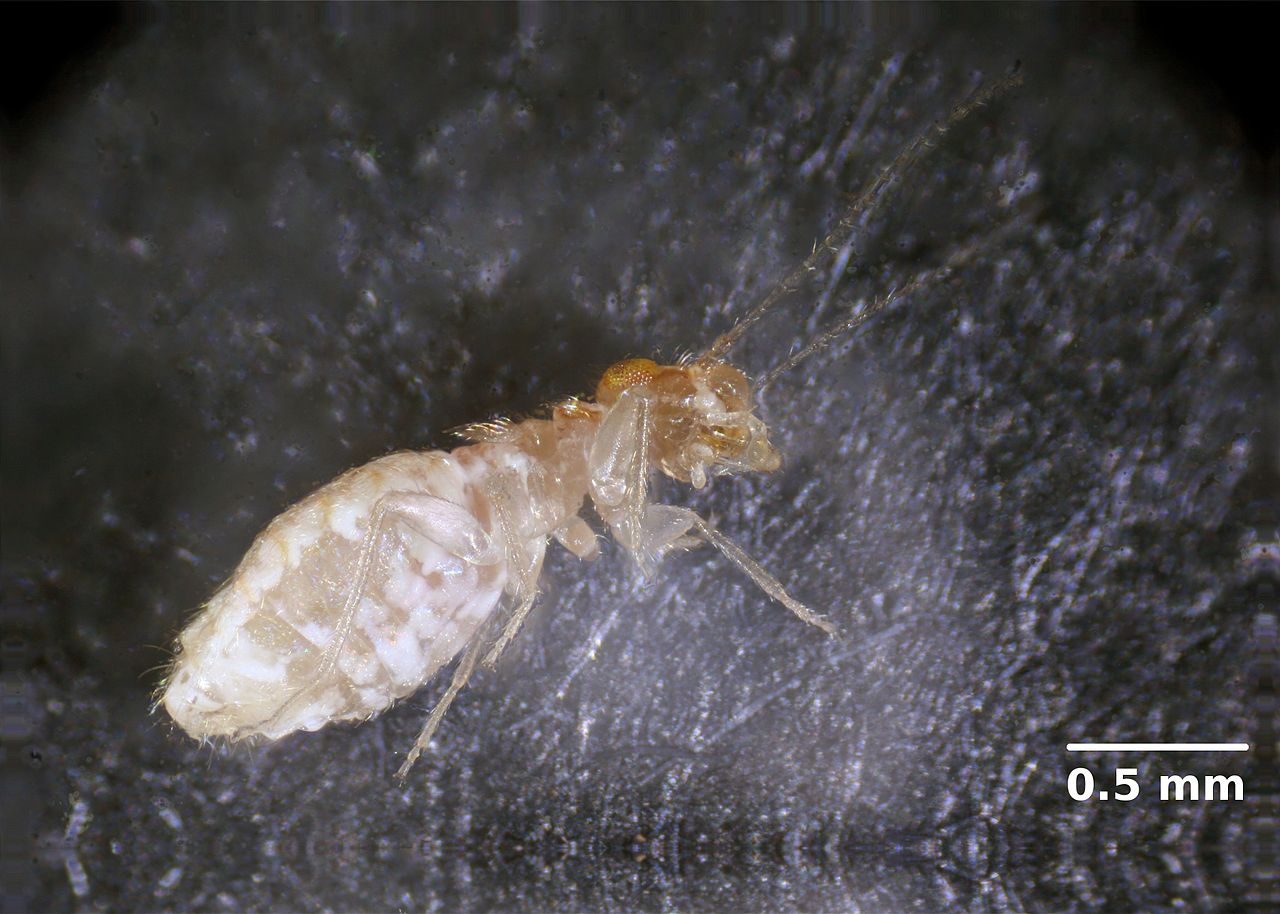
Booklouse or booklice are found on books in homes with high humidity.
Like other types of pests, these brown bugs thrive in areas with very high relative humidity.
It’s not the humidity itself that these bugs love but the mold humidity favors as they eat mold.
These bugs are very small sometimes not measuring more than 1mm.
Bugs of this genus are normally seen on various types of surfaces apart from books as well.
However, they do not post a direct threat apart from the distress they cause to homeowners.
Some studies suggest these bugs might be responsible for certain allergies.
However, these allergies can also be caused by the high humidity which favors these bugs.
Eliminating the bugs from your house involves managing indoor humidity levels.
29. Thrips

Thrips feed on the upper side of the leaves of various plants in the garden.
Most thrips are brown and they can make it into homes attracted to light or looking for food.
Thrips that grow wings can make it indoors easier.
Dealing with thrips quickly is recommended as they can damage potted plants in the house as well as other plants in the garden.
Thrips can be washed away with the hose in the garden. They can also be killed on the spot with an insect spray when found inside of the house.
Soap and water also kill thrips. You can mix soap with warm water to spray thrips you find in the house.
Introducing predators is recommended for long-term thrips management.
This is not a viable solution for thrips that are already in the house but it can be a viable solution for the bugs outside of the house.
Thrips are often commercially controlled by the introduction of lacewings.
30. Katydids
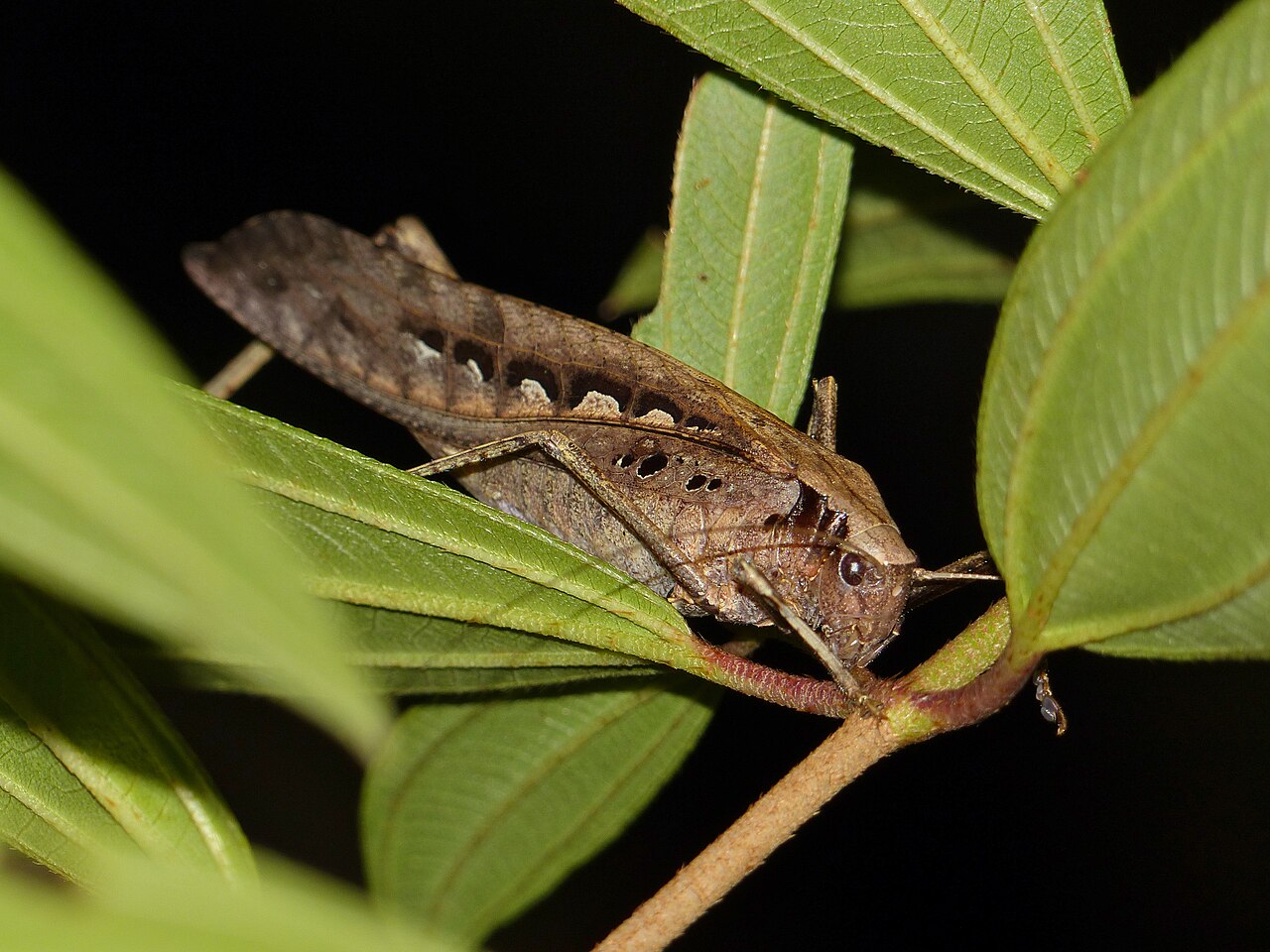
Katydids are mostly green but some members of the species are brown.
Some believe the color differences are the differences in appearance between male and female Katydids.
However, brown Katidids are mostly known for their adapted look which makes them more difficult to spot in their natural habitat.
Katydids are common on plants as they eat plants and plant leaves.
They are not seen as a major threat to gardens as they don’t multiply at considerable rates to cause significant crop damage.
These brown bugs might only damage a couple of plants within a few months.
However, Katydids should not be handled as they can bite.
The bite itself is quite painful. The pain subsides quickly and there are generally no side effects of the bite.
31. Termites
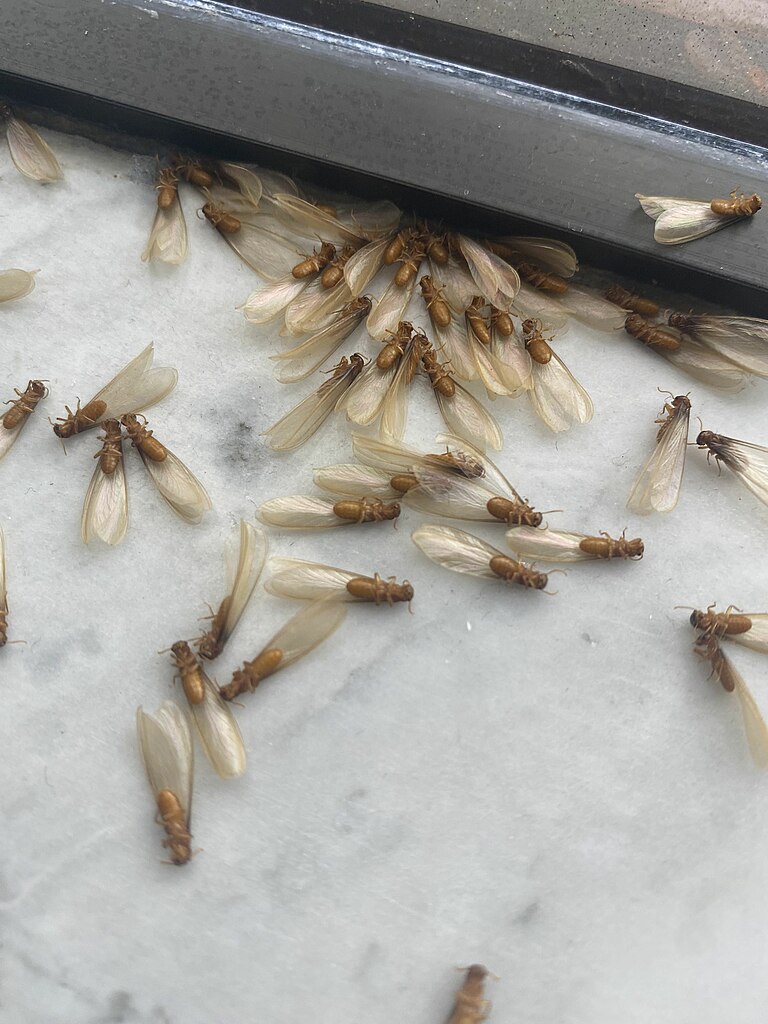
Subterranean termites are known for their brown color. These termites can also be white or yellow but many are brown.
Termites are known for their impact on wooden structures such as homes.
Since these tiny small termites live in the ground they easily transition to wood in direct contact with the ground.
Termites damage damp wood or wood that isn’t in perfect shape.
Unlike Brown Katydids, termites can create structural damage to a home.
They create underground tunnels that large termite colonies use to get to homes and to create maximum physical damage to wood by digging up galleries in damp wood.
Replacing damaged wood or wood affected by humidity is recommended to keep these small brown bugs away.
32. Earwigs

Earwigs have a dark brown color.
These bugs eat plants in gardens but they can also make their way to the house.
Earwigs get into homes by making the most of organic material such as mulch and leaves on the ground around the house.
These organic material layers favor high humidity and a comfortable environment for earwigs.
These bugs pose no real threat to humans if left alone.
However, earwigs can use their elongated pincers to pinch whenever roughly handled.
You can use a broom to swipe earwigs out of the house and refrain from killing them.
These bugs have a recycling benefit around the house as they eat decaying organic matter and insects. In gardens, they might have a detrimental role as they also eat flowers and plants.
33. Scorpions

Scorpions such as the Arizona Brown scorpion are known for their brown color.
Common in the area of the Sonoran Desert, this species is a true predator and a venomous creature that can kill.
These scorpions are a known dangerous species that needs to be removed from homes when found indoors.
Scorpions of this genus are kept away by building physical walls. These scorpions can’t climb surfaces they can’t grab onto such as smooth walls.
Scorpions need to be killed as they can make their way indoors as well.
Antivenin is given to those stung by this brown scorpion.
You need to clean the area of the sting if a scorpion stings. Soap and water are recommended together with ice or a cold compress before going to the hospital.
34. Pseudoscorpions

Pseudoscorpions are mostly black but they can also be tan or brown. These bugs look similar to scorpions but they cannot bite.
Making the most out of high humidity environments, Pseudoscorpions can move indoors in the basement or the bathroom.
They mostly feed on other insects. Pseudoscorpions eat spiders, flies, and thrips they find indoors.
However, they can still cause distress and they need to be removed.
Vacuuming is the best elimination method.
Once vacuumed, the home needs to be inspected for humidity levels.
A standard dehumidifier identifies the relative humidity levels inside a house and controls it so that these bugs aren’t attracted to the home anymore.
35. Harvestmen

Harvestmen are elusive tiny brown bugs. They are nocturnal and not easily seen during the day.
Harvestmen are atypical arachnids as their scavengers.
Their diet is a combination of cockroach diet and spider diets as they eat both decaying organic material including feces and living insects.
These bugs are ambush predators.
They like to pounce on prey at night. They also eat all types of organic material and decompose animals or insects during the day when odors attract them.
Keeping these arachnids out of the house is mainly subject to good sanitation.
Eliminating foods, decaying foods, dead insects, and roaches, and maintaining a clean home are the first steps toward keeping Harvestmen arachnids out.
These bugs don’t bite people. They have short fangs that don’t pierce human skin.
36. Leafhoppers

Some leafhoppers such as the Common Brown Leafhopper have a brown color.
These bugs feed on various plants to the point of killing the host plant.
Bugs of this genus are also common in other colors such as green and brown and sometimes make their way into homes by accident.
Leafhoppers are normally dealt with by spraying insecticides.
You need to consider other barriers when it comes to keeping these bugs out of the house.
Diatomaceous earth can be used to keep these bugs out.
You need to create a perimeter around the house that these bugs and others won’t cross.
You might need to vacuum leafhoppers if you still find them in the house.
While not very dangerous to humans, leafhoppers still need to be eliminated since they spread plant viruses.
They can damage plants by carrying plant diseases not only by eating them.
37. No-See-Ums

No-See-Ums are brown in their pupal stage. You know an emerging brown pupa in the house can be a future No-See-Um that needs to be eliminated.
Also known as Biting midges, No-See-Ums are small insects with painful bites.
You need to kill these insects from their pupal stage as they can develop into fierce adults that bite.
One of the biggest problems with these insects is their bites are potent and can come with adverse reactions.
As small flies, No-See-Ums can be managed by multiple methods which often involve homemade solutions.
Mixing and spraying water and essential oil are among the most recommended techniques for keeping these flies away.
You need to spray the entire area of the house so that the essential oil (lavender or peppermint) deter these flies.
38. Drain Flies

Drain flies are another type of distressing pest found in homes. These flies are either gray or brown.
They grow to a size of 1/8 inches.
Drain flies grow in dirty drains, as their name suggests. These flies are among the most prominent types of flies found in homes, especially in the kitchen.
While they don’t bite, drain flies can be annoying.
You need to maintain clean drains to avoid having drain flies inside the house.
Clearing organic material buildup from food residue in the drains is recommended.
You can also kill drain fly eggs by pouring boiling water down the drain or by pouring an anti-flies solution down the drain.
Checking for water leaks and other types of organic material buildup under the sink is also recommended.
These flies prefer the humid environment in the drain but they can sometimes find an alternative under sinks that are known for leaking.
39. Fruit Flies

Similar to drain flies, fruit flies are common in homes with abundant food.
These flies are mainly attracted to the overripe fruit they eat and lay eggs on.
Fruit flies can only be eliminated by removing all decaying fruit.
Storing fruits in the refrigerator or sealed containers is another method these flies can be kept away.
Fruit flies can be identified by their light brown body with very large red or rust-red eyes.
These flies can be killed by spraying them with a mixture of vinegar, soap, and water.
You need to spray the flies directly since they tend to move along quickly.
40. Rose chaffers

Rose chaffers have brown larvae. They have a brown-green body as adults and can sometimes be found indoors.
These bugs are seen in homes with many types of potted flowers.
Rose chaffers are imported from Europe and are known for the damage they created to flowers both indoors and outdoors.
Rose chaffers are also highly common in greenhouses with plenty of flowers.
The bugs can be eliminated by inspecting potted plants you buy and bring inside of the house.
Most homes with these bugs accidentally get them inside from infested flowers.
However, Rose flies might also be found in gardens where you make homemade compost.
The rich organic nature of compost attracts Rose chaffers who live and lay eggs in it.
Rose chaffers might also be found in homes surrounded by many roses as this bug prefers roses to all other flowers.